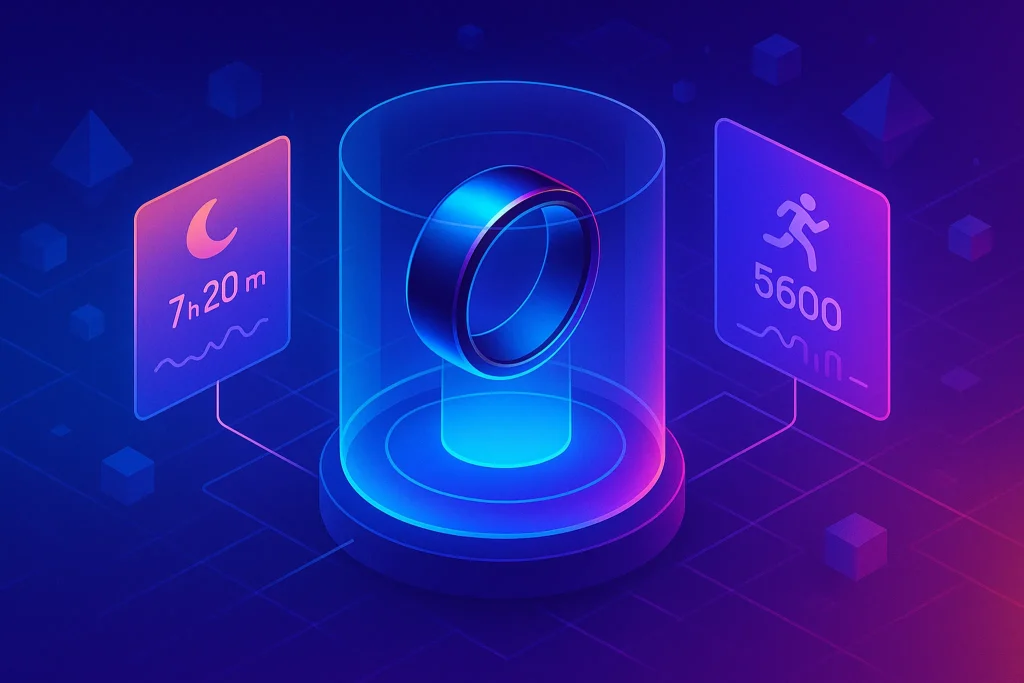Intro: The Rise of Digital Wellness Coaches
Staying healthy in today’s fast-paced world isn’t just about hitting the gym—it’s about having the right technology by your side. In 2025, wearable fitness gadgets have evolved into intelligent, personalized wellness coaches. Whether you’re tracking heart rate variability, sleep cycles, recovery time, or daily steps, these gadgets do more than just count—they guide, motivate, and optimize your health journey. Let’s dive into the top wearable fitness technologies that are changing how we live, train, and recover.
⌚ Smartwatches: Your All-Day Health Companion
Smartwatches are no longer just about checking texts. Devices like the Apple Watch Series 9, Samsung Galaxy Watch 6, and Fitbit Sense 2 come loaded with health-focused features:
-
Heart Rate Monitoring: Constant tracking with alerts for irregular rhythms.
-
ECG & Blood Oxygen Sensors: Providing insights into cardiovascular and respiratory health.
-
Activity & Workout Tracking: Auto-detection of workouts, movement rings, VO2 max estimates, and more.
-
Mindfulness & Stress Tools: Guided breathing, stress detection, and even mood logging (like in Fitbit).
What sets them apart is the seamless integration into daily routines—reminders to stand, movement nudges, and even sleep cycle analysis all within a sleek watch form factor.
📌 Smartwatches are ideal if you’re looking for an all-rounder with fitness, productivity, and smart assistant functions combined.
🧠 Long-Term Benefit: Building awareness of lifestyle patterns through passive, consistent data collection—turning small tweaks into significant health improvements.
📶 Fitness Trackers: Focused, Lightweight, Data-Driven
For those who want a health-focused device without the distractions of a smartwatch, fitness trackers deliver just that.
Top picks in 2025:
-
Whoop 4.0: Offers deep insights into recovery, strain, and sleep with no screen, pushing users to focus on performance, not notifications.
-
Garmin Vivosmart 5: Lightweight yet packed with oxygen tracking, stress scores, hydration reminders, and sleep insights.
What’s powerful about these devices is their emphasis on recovery and readiness. For example, Whoop calculates a “strain score” to let you know whether today is a push day or a recovery day—an approach elite athletes swear by.
🌟 If you train regularly or care about optimizing your energy for workouts, a dedicated tracker like Whoop can be a game-changer.
Many athletes already use Smart Rings That Track Sleep & Fitness for similar insights, especially in minimalist form factors.
💍 Smart Rings: Tiny Powerhouses for Wellness Tracking
The trend of minimal wearables exploded with the rise of smart rings. In 2025, devices like the Oura Ring Gen 3 and Ultrahuman Ring AIR bring top-tier tracking to your fingertips—literally.
These tiny devices track:
-
Sleep stages & recovery
-
Heart rate variability (HRV)
-
Body temperature trends
-
Daily readiness & activity scores
And best of all? You don’t have to charge them daily—most last 4 to 7 days. That makes them perfect for those who want deep health insights without wearing something bulky.
📦 Ready to Upgrade Your Health Stack?
Whether you’re focused on better sleep, smarter recovery, or daily performance gains, these next-gen wearables turn passive tracking into real progress.
🔹 Oura Ring Gen 3: Sleek, screenless, and powerful—track sleep, readiness, and recovery like never before.
🔹 Whoop 4.0: The go-to choice for athletes—optimize strain, monitor recovery, and crush your goals with science-backed insights.
Small gadgets. Big results. Make every heartbeat count.
You can also check our full breakdown of Wearable Tech in 2025 to see where smart rings fit into the broader ecosystem.
🤖 AI-Powered Workout Devices: Train Smarter, Not Harder
Imagine a personal trainer that adapts to your progress in real time. That’s what AI-driven devices like Tonal, Peloton Watch, or Tempo Move bring to your living room.
These gadgets use machine learning to:
-
Personalize resistance levels
-
Monitor form via motion sensors
-
Offer feedback during workouts
-
Generate adaptive programs based on fatigue and performance
In short, they replicate a gym experience—with AI coaching built in.
💪 Ideal for tech-savvy fitness enthusiasts or home gym owners looking for smart strength and cardio training.
🧠 Nerd Verdict: AI-based devices help maintain training consistency, especially for solo exercisers. They’re motivating, interactive, and adaptive—turning effort into evolution.
🎨 Watch vs Ring vs Tracker
| Feature | Smartwatch | Smart Ring | Fitness Tracker |
|---|---|---|---|
| Health Metrics | ✅ Full Suite | ✅ Focused | ✅ Moderate–Advanced |
| Display | ✅ Large Touch | ❌ No Display | ✅ Small Display |
| Battery Life | ⛔ 1–2 Days | ✅ 4–7 Days | ✅ 5–7 Days |
| Form Factor | ⛔ Larger | ✅ Ultra-Compact | ✅ Lightweight |
| Notifications | ✅ Yes | ❌ No | ❌ Limited |
| Recovery Insights | ⚠️ Basic | ✅ Strong | ✅ Strong |
💡 Motivation Layer: How These Devices Spark Action
Beyond raw data, these wearables leverage behavioral design to keep you moving:
-
Gamified Challenges: Daily step goals, streaks, badges.
-
Social Sharing: Compete with friends or family (e.g., Apple Fitness+ sharing).
-
Coaching Nudges: “You’re behind on your move goal,” or “Ready to train today?”
👣 Small nudges lead to big habits. Users who consistently wear these devices report a notable increase in physical activity, improved sleep, and better self-awareness.
🧪 Science Behind the Metrics: Why These Numbers Matter
Wearables aren’t just fancy step counters—they’re built on powerful physiological metrics that reflect how your body is performing and recovering.
For example:
-
HRV (Heart Rate Variability): A higher HRV generally means your body is recovering well and managing stress efficiently. Tools like Whoop and Oura use this to guide your daily effort.
-
Sleep Score: Derived from deep vs. light sleep stages, restlessness, and recovery patterns—helping you optimize not just quantity but quality of sleep.
-
Resting Heart Rate & Respiratory Rate: Key indicators for overall cardiovascular and respiratory fitness.
📊 When a wearable tells you to “take it easy today,” it’s backed by real-time biometrics—not guesswork.
🧠 Wearables & Behavior Change: The Psychology of Movement
One reason wearables are so effective is because they apply proven behavioral science principles to nudge you into better habits:
-
Cues & Reminders: Visual rings, buzzing alerts, or even emoji streaks act as daily cues to act.
-
Gamification: Hitting movement goals or earning badges taps into reward mechanisms in your brain.
-
Streaks & Accountability: Missing a day can feel like breaking a promise to yourself—thanks to clever UX design.
🧩 The tech alone doesn’t drive change—but it makes the process of habit formation easier, more consistent, and surprisingly addictive.
📊 Fitness Tech Is Booming: Numbers You Should Know
Health-focused gadgets aren’t niche anymore. In fact:
-
The wearable fitness tech market is projected to grow from $61B in 2022 to over $138B by 2028.
-
Smart rings are seeing explosive interest, with a 22% CAGR forecast, particularly among young professionals and biohackers.
-
Over 64% of smartwatch owners now use them primarily for health tracking—not messaging or calls.
🌍 If you’re investing in your wellness, you’re far from alone. The world is going wearable—and fast.
🔄 Stacking Your Health Stack: Why Some Users Wear Multiple Devices
Power users often combine different wearables to get the best of all worlds:
-
A Whoop strap for deep strain/recovery analysis
-
An Apple Watch for workout tracking and smart features
-
An Oura Ring for passive sleep + readiness data
Each device specializes in something. Stacking them means fewer blind spots and smarter decision-making about training, rest, and daily rhythm.
🎯 For serious fitness enthusiasts or data geeks, the combo approach provides a 360° view of health performance.
🧠 Long-Term Wellness: More Than Just Tech
Wearing a device doesn’t magically make you healthy—but it builds a feedback loop:
-
Track habits ➝ Understand patterns ➝ Adjust behavior ➝ Improve outcomes
Consistent use of wearable fitness tech has been linked to:
-
Lower resting heart rates
-
Improved sleep scores
-
Reduced stress indicators
-
Greater workout adherence
📈 Nerd Tip: Want to double down on your goals? Our Tech for Fitness guide shows how to combine gadgets, apps, and mindset tools into a full-stack fitness lifestyle.
🛡 Data Privacy & Wearables: What Happens to Your Health Info?
As wearable tech gets smarter, it also gets more personal—tracking everything from your heart rate to sleep cycles, and sometimes even emotional states. That raises a critical question:
Where does all that data go? And who has access?
Here’s what you should know:
-
Most brands like Oura, Whoop, and Fitbit anonymize your data to improve algorithm accuracy and provide better insights.
-
However, some platforms require a subscription, and data collected may be used for research or product partnerships.
-
Devices integrated with broader ecosystems (like Apple or Google) may share health metrics across apps—beneficial for personalization, but worth reviewing in privacy settings.
✅ Nerd Tip: Always check the privacy policy and opt-out settings. Tools like Apple Health give you granular control, while others may need a deeper dive.
🔒 Your health data is powerful—it can help you thrive, but it’s also worth protecting. Choosing brands with clear privacy standards and transparent terms is just as important as the features themselves.
🧠 Nerd Verdict
In a world where health is wealth, wearable fitness gadgets act as constant companions, coaches, and motivators. They don’t just tell you what you’re doing—they help you do better. From rings to watches to AI-powered workout mirrors, fitness tech in 2025 isn’t about hype—it’s about action.
❓ FAQ: Nerds Ask, We Answer
💬 Would You Bite?
Which wearable would you trust as your personal health sidekick—something visible like a watch, or invisible like a smart ring?
Let us know what motivates you to stay on track.



